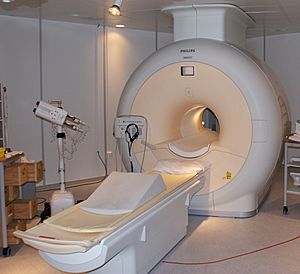Nuclear magnetic resonance facts for kids
Nuclear magnetic resonance (NMR) is a cool science trick where tiny magnets inside atoms (called magnetic nuclei) can soak up and then release energy. This happens when they are placed in a strong magnetic field. The energy they absorb is a special type of radiation called radio frequency (RF) waves.
The specific energy they absorb depends on how strong the magnetic field is. It also depends on the type of atom. Scientists use NMR to study how molecules are built. They also use it to learn about different materials, like crystals.
One of the most important uses of NMR is in medical imaging. You might have heard of magnetic resonance imaging (MRI). This is a way doctors can see inside your body without needing to cut you open!
A main idea behind NMR is that each substance has a unique "tune" it resonates at. This tune changes depending on how strong the magnetic field is around it. This is super useful for imaging. If you put something in a magnetic field that isn't perfectly even, different parts of the object will resonate at slightly different tunes. This helps scientists create detailed pictures. The stronger the magnetic field, the clearer the picture they can get!
The basic idea of how NMR works involves two main steps:
- First, the tiny magnets inside the atoms line up in a strong, steady magnetic field. Think of them like tiny compass needles pointing in one direction.
- Next, a quick burst of radio waves (like the ones your radio uses) is sent out. This burst makes the tiny magnets wiggle a little bit out of line. The radio wave's frequency is chosen carefully to match the atoms being studied.
NMR is used in many ways. It helps scientists study materials and even helps doctors see inside the human body with MRI scans.
History of NMR
The idea of nuclear magnetic resonance was first discovered by a scientist named Isidor Isaac Rabi in 1938. He studied how atoms behaved in magnetic fields. For his amazing work, Rabi won the Nobel Prize in Physics in 1944.
Later, in 1946, two other scientists, Felix Bloch and Edward Mills Purcell, made NMR even more useful. They figured out how to use it for liquids and solids. Before them, it was mostly used for gases. Bloch and Purcell also won the Nobel Prize in Physics in 1952 for their discovery.
Edward Purcell had worked on radar during World War II. This work taught him a lot about creating and detecting radio waves. This knowledge helped him understand how atoms could absorb these waves.
Rabi, Bloch, and Purcell noticed that certain atoms, like hydrogen (1H) and phosphorus (31P), could absorb radio wave energy. This only happened when they were in a magnetic field of a specific strength. When an atom absorbs this energy, it is called being in resonance. Different atoms in a molecule will resonate at different radio frequencies, even in the same magnetic field. By looking at these different frequencies, scientists can learn a lot about what a molecule is made of and how its atoms are connected.
After World War II, NMR became a very important tool. It was used in analytical chemistry (studying what things are made of) and biochemistry (studying living things). This happened as new electronic technologies became available for everyone to use. In the 1960s, a scientist named William Lipscomb was a pioneer in using NMR to study the shapes of molecules. He figured out how to read NMR data to see which atoms were linked together in a molecule. This is called understanding the "chemical shift."
Images for kids
See also
 In Spanish: Resonancia magnética nuclear para niños
In Spanish: Resonancia magnética nuclear para niños







